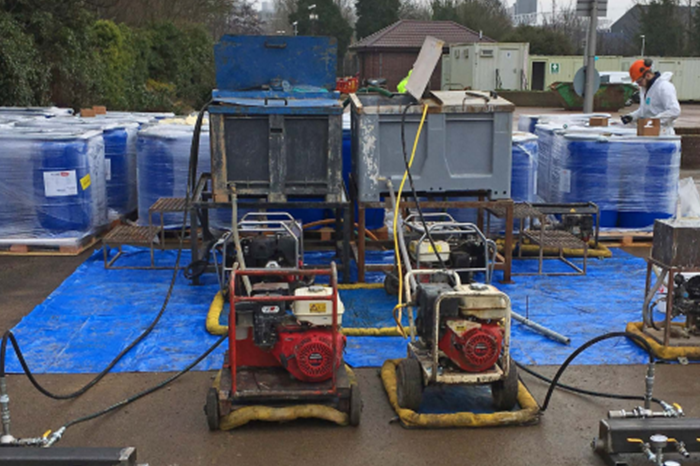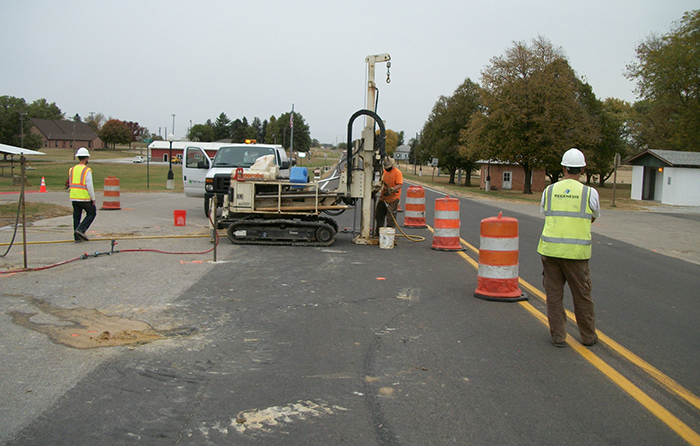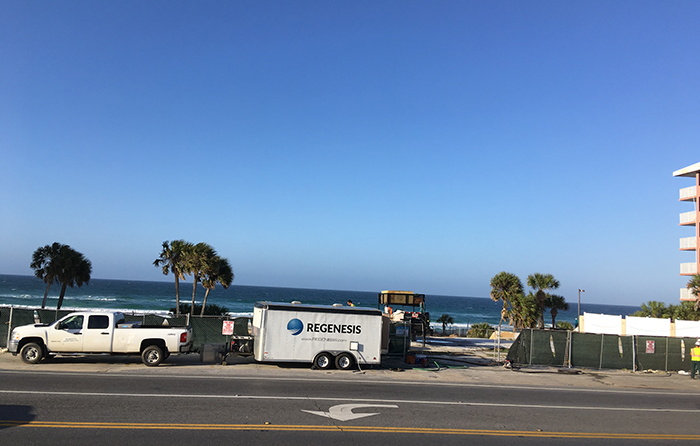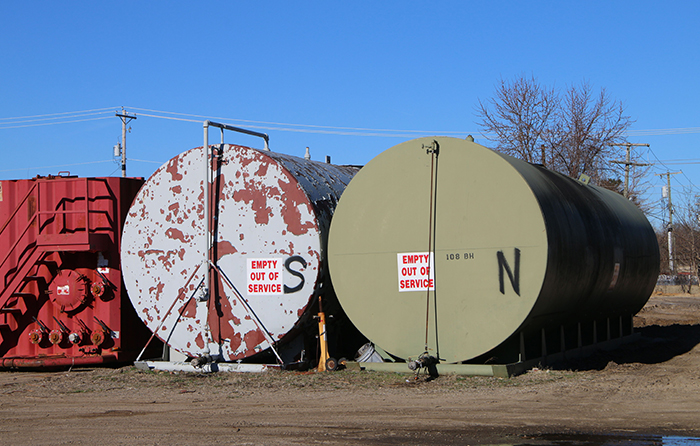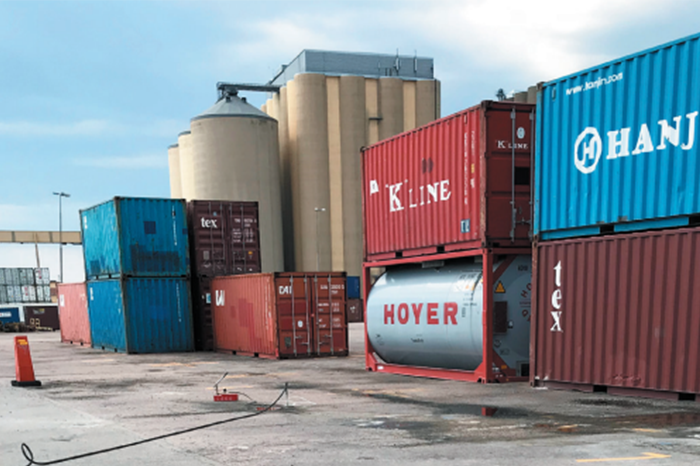Pesticides, VOCs and petroleum hydrocarbons remediated with a suite of in situ technologies
In Situ reagent barriers (HRC) treat contaminated groundwater in sandstone under a schoolRead More
Petroleum Hydrocarbon Plume Treated to Non-Detect within 50 Days
Case study highlights:
- Thorough Design Verification Testing (DVT) program helped to create a unique design for effectively treating the contaminant plume.
- Cost-effective design and application required a single application event.
- The remedial approach successfully treated a 200 ft. long dissolved phase hydrocarbon plume within the first 50 days.
This case study reviews an active gas station in Nebraska that was adversely impacted by a dissolved‑phase, hydrocarbon plume. The treatment solution from REGENESIS was successful in reducing the concentrations of BTEX, TPH-G, and MTBE to non-detect levels. REGENESIS conducted a thorough and innovative DVT program prior to remediation in order to ensure an effective remedial design. They used the DVT to produce a design which fit the precise needs of the site as well as the client’s budget. After the successful treatment, the consultant continued to monitor the groundwater trends until the Nebraska Department of Environment and Energy (NDEE) granted the site closure status. The on-site gas station has remained open for business.
Excavation With RegenOx Successfully Treats Large PHC Plume
Case study highlights:
- After previous consultants attempted remediation without success, C&S created a remediation strategy that successfully reduced the plume.
- The combined remedy approach of excavation and ISCO exceeded the remediation goals.
- Successful remediation enabled the construction of a 350,000 sq. ft. $110 million facility at the Buffalo Niagara Medical Campus.
This case study reviews a former gas station site in Buffalo, New York that required remediation due to leaking underground storage tanks. Together with REGENESIS, C&S Consulting designed an in situ remediation strategy to target the residual contaminant plume. RegenOx® in situ chemical oxidant was chosen because of its ability to target petroleum hydrocarbons and its non-corrosive properties. As part of the New York State Department of Environmental Conservation (NYSDEC) Brownfield Cleanup Program, C&S designed a complex remediation program to ensure a quick and affordable solution. Petroleum contamination extended from 10 to 40 feet below grade. The site was excavated to 26 feet below ground surface to remove residual contamination and to enable equipment staging and material handling areas to support the deeper excavation area.
Innovative Approach Reduces Benzene To Achieve Closure
Case study highlights:
- Exceptional benzene reduction using PersfulOx quickly reduced contaminant levels within a short timeframe.
- Design Verification Testing (DVT) fine-tuned the application to increase effectiveness.
- Addition of PlumeStop application ensured against back diffusion to help reach site closure.
This case study reviews a gas station site in Greenville, Alabama where petroleum hydrocarbon contamination was present in the subsurface for decades. PersulfOx, PlumeStop, and ORC Advanced were applied to quickly reduce benzene levels to non-detect, resulting in successful regulatory closure. This site is part of an environmental liability transfer and Antea Group®, an international engineering and environmental consulting firm, assumed the liability for this site. Antea Group required an effective remedial solution that would result in rapid site closure. Antea Group partnered with REGENESIS® to create a remedial design using an in situ chemical oxidation (ISCO) treatment paired with an aerobic bioremediation technology to ensure a complete treatment of this site.
PetroFix Successfully Treats Residential Fuel Oil Leak
Case study highlights:
- PetroFix successfully remediated the fuel oil contaminant spill and the site achieved regulatory closure.
- After three quarters of sampling the contaminants were below groundwater exceedance levels and within Method 1 standards for groundwater.
- Combined remedial approach included excavation and PetroFix injection.
This case study reviews a residential site in northwestern Massachusetts where the groundwater was contaminated with 200 gallons of home heating fuel oil. PetroFix Remediation Fluid reduced the heating oil constituents to below detectable limits, resulting in successful regulatory closure. After an excavation, WjF GeoConsultants created a remedial plan for the impacted groundwater which employed PetroFix to treat the remaining petroleum hydrocarbons. PetroFix is an affordable and effective technology which removes hydrocarbons from the dissolved phase and then stimulates hydrocarbon biodegradation by adding electron acceptors. In October 2018, WjF applied 800 lbs of PetroFix Remedial Solution. Following the application, WjF conducted three quarters of sampling which indicated that the contaminants were below groundwater exceedance levels and were within Method 1 Standards for groundwater. Following the third sampling event, the site received regulatory closure from the state.
PetroFix and ORC Advanced Excavation
Case study highlights:
- Success at this site can shape and improve the treatment of other similar sites
- PetroFix technology allowed Antea Group to design a remediation strategy that was fast, affordable, and highly effective
This case study reviews a former gas station site where Antea Group developed an excavation plan involving PetroFix™ and ORC Advanced® pellets to address contaminant levels following the excavation and removal of contaminated soil. This marks the first site where the remediation plan employs applying a mixture of both PetroFix and ORC Advanced pellets at the base of the excavation along with spray-applying PetroFix to the sides of an excavation pit. Antea Group was tasked with the remediation of the site. Working with the REGENESIS team, Antea Group specified the application of PetroFix in conjunction with the excavation due to the product’s ability to sorb and biodegrade petroleum hydrocarbons. The remediation design called for mixing PetroFix and ORC Advanced pellets into the base of the excavation site and applying PetroFix to the sides of the excavation pit.
Non-Detect Achieved at Florida Spill Site
Case study highlights:
- Unlike other approaches applied onsite, PetroFix met targets within 60 days and has remained below this target level for a year
- PetroFix was able to degrade the petroleum contaminants within a fast-moving, 150-yard plume
- Due to the successful pilot test results, Advanced Environmental Technologies, LLC (AET) has applied for a full-scale application through the FDEP
This case study reviews a multi-use convenience store site in Panama City Beach, Florida impacted by contamination from a leaking underground storage tank (UST), where PetroFix™ Remediation Fluid, a micro-scale carbon suspension with soluble electron acceptors, was applied to reach target goals within 60 days. AET sought out a technology that was affordable and would be guaranteed to lower the contaminant levels below the target levels. AET partnered with REGENESIS to conduct a pilot test using its new PetroFix activated carbon amendment. PetroFix is successful in high concentration source areas because it provides a permanent, in situ sorptive and biologically permeable reactive barrier (PRB). AET chose this technology because it offered a cost-effective solution that would quickly address the groundwater concentrations.
PetroFix Pilot Study Leads to Full-Scale Application
Case study highlights:
- Beta test of PetroFix provided promising results leading to a full-scale application
- At just one month post-injection, the petroleum VOCs and gasolinerange organics were essentially eliminated from the groundwater and remain so at nine months
- PetroFix remedial solution is designed to remediate petroleum contamination completely at the lowest total cost to closure
- Collaborative remediation success between Patriot, Microbial Insights, and REGENESIS
This case study reviews a former bulk petroleum storage facility where a groundbreaking application of PetroFix™ Remediation Fluid, a micro-scale carbon suspension with soluble electron acceptors, is successfully treating petroleum hydrocarbons to IDEM standards. REGENESIS worked with Patriot Engineering and Environmental to develop a remediation solution using PetroFix, which is uniquely designed to address petroleum hydrocarbon contaminants. The site was considered a viable candidate for the beta test, due to the high contaminant levels and provided a good test of the product’s performance at high concentrations. REGENESIS and Patriot agreed to move forward with the development of the beta test with the intention of evaluating its possible full-scale use following the results of the test. The promising results from the beta test and 12 months of post-injection monitoring indicate PetroFix to be a viable remedial option for this site.
Innovative In Situ Application of PetroCleanze Uses Horizontal Wells
Case study highlights:
- Innovative design and creative solution using horizontal wells to apply PetroCleanze and minimize daylighting
- The horizontal well system allows for the active gas station to continue to conduct business without disruptions
- Staying open during remediation efforts saved gas station owners an estimated $8,000 per day
- PetroCleanze was successfully applied despite the challenging lithology and shallow bedrock
This case study reviews an innovative remediation design at a site that is using two horizontal wells which will administer a total of four injection events, with enhanced fluid recovery (EFR) events being performed before and after each injection. BTEX contamination and free-phase product from a petroleum release was discovered in the groundwater at an active gas station in Colorado. After previous remediation attempts from prior consultants, CGRS, Inc., Paragon Consulting Group, Inc., the Colorado Division of Oil and Public Safety (OPS), and REGENESIS® collaborated to create a design that would successfully remediate the persistent groundwater contamination and free-phase product.
In Situ treatment of toluene in groundwater, Helsingborg, Sweden
In Situ reagent barriers (HRC) treat contaminated groundwater in sandstone under a schoolRead More

 Americas
Americas Europe
Europe Français
Français Deutsch
Deutsch Italiano
Italiano Español
Español